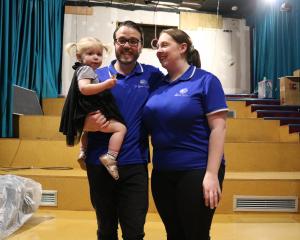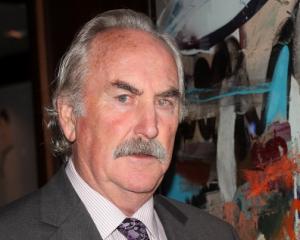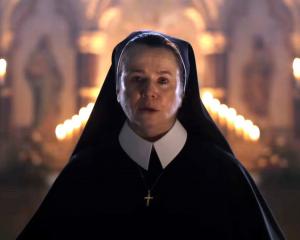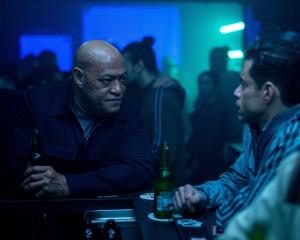Dakota Fanning's porcelain-doll features were swathed in exotic makeup and her blonde hair coiffed into a feathery shag; she raised her umpteenth shot of sake and cast a knowing glance at Kristen Stewart.
The Twilight star held Fanning's gaze briefly and toasted back, looking every inch the tough rocker chick, with her matching black shag hairdo, spiked bracelet and razor-blade charm necklace.
The actresses clinked glasses and giggled.
With downtown Los Angeles' Kyoto Grand Hotel standing in for a bustling Tokyo sushi joint, the teen stars were on the set of the coming-of-age drama The Runaways - in character, with Fanning as Cherie Currie, the wild-child lead singer of the titular all-girl rock group, and Stewart portraying Joan Jett, its electric-guitar-wielding, 'tude-copping founder.
Between the years 1975 and '79, the Runaways packed shows, toured the world and racked up hits before self-immolating in a blaze of drugs, jealousies and in-fighting.
The Runaways is one of the most piquantly feminist films to touch down this year - albeit a punk-infused genre pic with a pronounced generational viewpoint and no shortage of blood, drug abuse and bodily effluvia.
Written and directed by Floria Sigismondi, the acclaimed photographer and music-video director behind such atmospheric clips as Marilyn Manson's The Beautiful People and Christina Aguilera's Fighter, the movie is less intended as a by-the-book musical biopic a la The Doors or La Bamba than an impressionistic character study illuminating a unique female predicament: What happens when teenage girls get handed too much, too soon via worldwide rock stardom?
No stranger to the rock'n'roll life in her own right, the Italian-born first-time feature director - a striking woman with a mane of raven-black hair who was clad in a vampire-chic, all-black ensemble on set - says she drew on personal experience to connect with the characters.
"It's young girls getting swept up into a world they couldn't handle," Sigismondi says.
"Feeding on those confusing feelings that develop from moving from girl to woman, I could reach deep into myself to find those things."
Sigismondi, who is married to Lillian Berlin, lead singer of the hard-rocking alt-quartet Living Things, continues: "I wanted to focus on Joan and Cherie.
"How different they are, how they were drawn together for this crazy experience.
"Joan is so focused, she really wanted to have this band. And Cherie wanted the rage of rock 'n' roll, the rebellion."
The film follows Currie at age 15 as she chafes against suburban torpor and her family's psychological abandonment en route to becoming the most forward female face in rock.
On a parallel track, Jett is shown raging against the proverbial machine, defying all cultural expectation to stake out her place as a young woman in the boys' club of hard rock while still in her mid-teens.
One night in Hollywood, Jett approaches record impresario Kim Fowley (a scene-chewing Michael Shannon in campy glam drag) who introduces her to drummer Sandy West (Stella Maeve) and becomes the band's Svengali.
Fowley "discovers" Currie at a nightclub, installs her as frontwoman and even concocts the lyrics to one of the group's biggest hits, Cherry Bomb, on the spot during Currie's audition.
Scant character development is devoted to West and bandmate-guitarist Lita Ford (Scout Taylor-Compton).
Ford went on to become heavy metal's reigning queen during the 1980s.
Another early member was bassist Micki Steele, later known as Michael Steele in The Bangles.
Fowley, whose eclectic resume would eventually range from KISS to Helen Reddy, had a vision for a new kind of girl group.
As he explained in a recent interview, he had noticed two parallel trends in the early 1970s: women's liberation and male androgyny.
"The feminisation of American males," Fowley said, "began the day feminism started."
The sound was hard-charging, the attitude rebellious and the T-shirts tight (the band's very name offered a hint of sleaze).
Raucous shows at clubs and house parties led to a deal with Mercury Records and a self-titled debut disc in 1976.
For all their success, however, The Runaways found themselves jeered as much as hyped by a male-dominated music press.
"It was a little derogatory, but they were excited about them, too," says Sigismondi.
Judging by the media coverage "audiences were a little bit confused when they saw The Runaways for the first time: 'They're sexy, but they're all girls! Should they be doing that? My God, they're 15! Can they actually play?'," she says.
Their own manager didn't treat them much better.
In the film, Fowley is depicted as a sneering tyrant who refers to the girls as "dogs" and hires hecklers to pelt them with objects during rehearsal.
Still, both Jett and Currie remember him with a certain bemused fondness.
As for Fowley, he remains unrepentant: "Abuse? Shut up and play".
Producer John Linson points out that even though the Runaways is partly based on Currie's 1989 memoir Neon Angel: The Cherie Currie Story, The Runaways is not a "band film" per se, because the film-makers did not secure life-story rights for all the band members.
Instead, the grander ambition was to faithfully capture "the youth ethic in film".
"It's about 15-year-old rock stars, the rise and fall of kids," Linson said.
"We're trying hard not to let that get taken away."
Profligate prop-sake consumption aside, Fanning (16) and Stewart (20), appear side by side in an overwhelming majority of the movie's scenes.
The two are shown snorting cocaine in an aeroplane bathroom as well as getting closer still in one of The Runaways primary talking points: a make-out scene in a roller rink that takes place about two-thirds of the way through the movie.
The scene was inspired by a remark Currie made in the rockumentary Edgeplay: A Film About the Runaways, made by former band member Victory Tischler-Blue.
"In Edgeplay, Cherie mentions that Joan is really good in bed," Sigismondi said.
"I thought, 'I have to pry into this a bit. It will cause an explosion in the film. Why not go there?'."
Stewart and Fanning first shared screen time in The Twilight Saga: New Moon and became fast friends.
"You can probably tell we get along really well," Fanning says in between takes.
"For the characters, it's really important that bond is portrayed. And we have that in real life."
Rather than talk up the more sensational aspects of filming - like, say, the scenes in which Fanning writhes and vamps on stage dressed in fishnet stockings and a revealing bodice - the actress chooses to explain how she and Stewart rehearsed the Runaways' music together for a month before filming began.
"When you're up there and you hear yourself singing the songs and feel yourself performing the dance moves that are so iconic - when you're up there having the time of your life - you feel like you are those girls for a few minutes," Fanning says.
"It's really fun!"For Fanning, who was 15 at the time of filming, the role of vocalist Cherie Currie allowed her to step into edgy young-adult territory.
"I did it because I really loved the character of Cherie, not knowing anything about the Runaways," Fanning says.
"I wanted to be able to play that out and live her life for a little bit."
For Stewart, who plays tough girl guitarist Joan Jett, it was a chance to rebel against the defining role of her young career, Twilight damsel-in-distress Bella Swan.
Stewart felt she found a kindred spirit in Jett.
"We have been professional at a young age, which is hard, but her in such a different way. The biggest adversity I face is bloggers.
"She had people throwing bottles in her face and saying, `Sit down, you ugly loudmouth'. She's a survivor."
Stewart had to learn Jett's signature guitar moves (the rocker offered X-rated advice that can't be repeated here), but she has been playing for quite a while.
She got her first guitar at 10 when she was in Panic Room, the David Fincher thriller starring Jodie Foster.
But she did not go through the adolescent phase of rocking out to invisible audiences in her bedroom.
"I've always really loved music, but for some reason acting seemed like something I could do and it was gonna happen.
"It's easy to hide behind a character and do anything you wouldn't do yourself. I'm not going to go be in a band."
Playing the guitar did help her land a role in Sean Penn's Into the Wild.
She got the part of a free spirit living in camping ground when she strummed Blackbird on the guitar for Penn.
"I played really badly for him and he said, `That's perfect, you can't be very good'."
Rock was a symbol of countercultural rebellion in the 1970s, explicitly so in a scene where Jett sasses a music teacher who informs her "girls don't play electric guitar".
Stewart had "grown up thinking I could do and say pretty much anything I wanted, [but] Joan only talks about the opposite of that.
"She says over and over she was told to shut up. And that her look was just ugly and she was crass."
Playing Jett was "a totally different experience" from a fictional role, she said.
"In fiction you can make something up and fill in the blanks to a degree. This was not like that at all.
"Whenever I had a question, I never tried to answer it. I just asked her.
"We had three weeks together to run songs and we were together constantly every day for that three weeks.
"And it was the same throughout the movie. I needed that. Without that I would have felt so false."
During production, the real Joan Jett was a semi-constant presence on-set.
At the Kyoto Grand location, the rock icon huddled with Stewart conspiratorially in between takes, their closeness highlighting a remarkable physical similarity.
In the film, Stewart convincingly channels something of Jett's androgynous, take-no-guff demeanour and rock-star swagger.
"She has completely embodied the character of Joan," Sigismondi says.
"Her body language, her face, her walk. It's amazing how she has just become her."
Production designer Eugenio Caballero is even more blunt.
"Kristen is Joan," he says in between scenes.
"You talk with her and you think it's Joan Jett."
The notoriously private rocker, whose post-Runaways project Joan Jett and the Blackhearts' I Love Rock 'N Roll famously hit No 1 and has sold more than 10 million copies, admits feeling a strange satisfaction while watching the actresses perform the Runaways' music.
"It's surreal, that's all I can say," Jett says.
"But I have a smile on my face."












